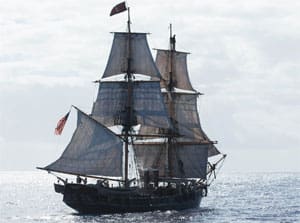In 1819, the whaling ship Essex departed Nantucket on an ill-fated voyage that ended in a Pacific sinking after its hull was stove in by a whale — a story that many call “the real Moby Dick.” Essex’s crew was forced into the ship’s boats for a survival voyage of thousands of miles. The film In the Heart of the Sea, making its debut in cinemas in December 2015, is based on the brilliant Nathaniel Philbrick history of Essex by the same title.
As the survivor of more than two and a half months in a life raft in 1982 [editor’s note: Callahan’s best-selling 1986 book about his ordeal is Adrift, 76 Days Lost at Sea], I have worked as technical consultant on several films, including In the Heart of the Sea. This film brings to mind the vast differences between ocean survival craft and equipment of 200 years ago and today. Conversely, survival stories pulled from recent headlines also remind us how little the needs and realities of mariners in distress have changed.
In those antiquated times, survivors figured that surviving a ship sinking was about as likely as surviving an air crash today. Very few sailors had survived any length of time at sea, and nightmare scenarios were better known, such as when the frigate Medusa grounded on a reef in 1816. Then, the 147 people who were cast adrift on a raft were reduced to only 15 in 13 very unlucky days.
Into the 1930s, little changed. Generally, survivors crawled into emergency craft feeling justifiably doomed. During the early days of World War II, so many young men were dying at the hands of U-boats that Outward Bound was created to shift attitudes and training. After the war, Frenchman Alain Bombard furthered the effort with his voyage on the inflatable Heritique, which he sailed across the Atlantic in 1952. His goal was to prove that people could live off the sea, a concept that might seem self-evident, but was routinely ignored throughout history as shipwreck survivors would not even bother to fish, pinning all their hopes on rescue.
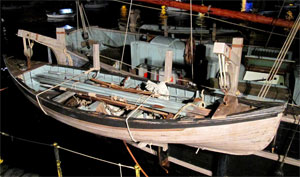 |
|
One of the whaleboats used in the movie. |
Whale attack
When Essex sank, the whaler was 2,000 miles offshore. A large bull sperm whale smashed in her bow in blows so hard that she was driven backwards. For two days, the crew remained attached to their mother ship as it broke apart, fitting jury-rigs to their longboats and collecting what they could that might be useful during a long voyage that only eight of them would survive.
The Essex crew must have felt truly lost when their ship finally slipped away. Unlike today, shipping was a rarity, and offshore search and rescue (SAR) operations non-existent. Only Essex’s officers would have had a working knowledge of currents, oceanography, wind and weather, and it paled in comparison to what we know today. They didn’t even have reliable charts, not to mention EPIRBs, GPS and other contemporary gear. On the other hand, through their daily existence and work, they knew the physical oceanic world intimately. The 20 crewmen were tough, resilient, and the “survival” gear that they had they used routinely and was of high quality.
They would make one critical mistake, however. Trapped in the culture and rumors of their times, they so feared “savages” and cannibals in the very reachable Marquesas, a couple weeks’ sail downwind and down current, that they would seek South America, upwind and up current, which required them to take an indirect route 1,000 miles south and then 3,000 miles east — which they did, in three, open 28-foot rowing boats with only about 6 feet of beam, and carrying what they could salvage from the wreck of Essex. The irony, of course, is that they would likely have been fine in the Marquesas where other Europeans and Americans had visited (and in later years, Melville would jump ship and write about in Typee). Worse, the cannibalism they feared would soon come to a boat near them.
For the film, period longboats were heavily researched and meticulously reproduced, although with hulls of fiberglass and of slightly smaller size (24-footers). Longboats of that time had three rowers to starboard and two to port. No boat is that easy to row in the open sea, as stunt men and actors would find out, but the boats are very lively and incredibly easy to push. The Essex crew would have been very adept at rowing them, but it was unlikely that they would row much of the 4,000 miles while harshly starved. The longboats in that era were not equipped to sail. The crew did fit jury-rigs, though; at least one very similar to those fit on the movie boats.
I sailed the movie boats under jury-rig a bit. Because they lacked centerboards, I found them pretty hopeless upwind, although they could crab to about 60 degrees off the breeze. In light airs in a chop, you pretty much had to wear ship to come up on the other tack. But off the wind, even though their narrow beam made them pretty tippy and wet and they could roll a good bit, they steered well and slipped along, even in quite light airs.
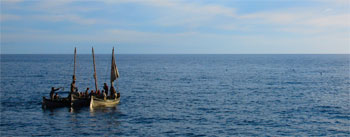 |
|
After Essex sank 2,000 miles offshore its 20 crewmen took to three small boats. |
Fortunately, the Essex crew knew their boats well by using them routinely in the open sea. They also were relatively tough craft, having to stand up to the rigors of whaling. In addition, the men could repair these wood craft en route, which is lucky because whale boats lived a very hard life, and, even as they began their voyage, the Essex’s were already beaten up and leaking. Fortunately, these boats would not sink and survived getting swamped during whale hunts, but bailing a flooded whaleboat at sea can prove near impossible. We towed ours ashore.
Survival craft
Today, of course, we can choose from a range of survival craft, including life rafts, rigid lifeboats or dinghies fit out to serve that purpose. With a probable living area of about 110 square feet in the Essex longboats, each of the six to seven crew per boat would have enjoyed about 15 square feet of space, three times the 4 square feet per crew afforded to a modern crew in a certified life raft, but that likely was one of few advantages. Thwarts, hard surfaces and heaps of gear would make resting difficult to a crew suffering injuries and sores. There was no protection from the sun or waves other than a small square of canvas aloft and some inches of freeboard.
The longboats’ biggest potential advantage over modern and rather clunky lifeboats or life rafts was maneuverability and speed. Of note, modern survival craft affiliated with commercial vessels do not usually have to travel very far before rescuers are on site. For them, contemporary communications and SAR services have vastly changed the strategy for rescue. On the other hand, speed and maneuverability can allow survivors to intercept rain, pick up useful flotsam or get closer to passing ships. Having a sense of being able to control one’s own destiny also can be a godsend in building confidence aboard. When a crew is required to save itself, especially those cruisers out of reach of SAR assets, the ability to move and control direction even quite modestly can be surprisingly effective. An extra knot of raft speed would have shortened my drift from 76 days to just 37 and the Butlers from 66 to 26. Beam reaching at just 1.5 knots would have taken me to the Cabo Verde Islands in a mere 15 days, and the Robertsons could have reached the Galapagos in six days rather than drifting off for 38. Being able to drift just 30 degrees off dead downwind at just 1.5 knots would have landed the Baileys in the Galapagos 300 miles away in eight to 12 days. Instead, they drifted for 1,500 miles over 119 days.
Unfortunately, life rafts (and many lifeboats) have virtually no maneuverability, although I managed to vary my course slightly in 1982 by towing a line. Kiteboarding and related kite development, however, provides us with very efficient rigs for any survival craft and take little space to store. Lifeboats also can be fit with efficient, more conventional sailing rigs.
Lifeboats built with light core materials and composites make them equally unsinkable and less liable to need basic repair than the Essex boats. From 2013 into 2014, José Alvarenga spent 13 months drifting from Mexico all away across the Pacific in a 24-foot fiberglass panga, an astounding feat. Although his boat was not a survival craft, with no seams able to open up or other basic structural problems, the boat spared Alvarenga from spending a lot of energy on repairs. He also could remain dryer, and had a large area in which to collect rain. Lifeboats with watertight lockers and/or foam floatation can float high enough when swamped to maintain precious freeboard, allowing the crew to bail them out. Floating higher also lends much better stability in the swamped state.
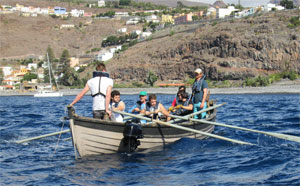 |
|
Practicing off Gomera in the Canary Islands. |
Rafts are another matter altogether, of course. To facilitate deployment and compact storage, rafts are kept small and light. Rafts are necessarily very crowded when filled to capacity, and not all that roomy even with a minimal crew. A prime benefit, though, is that even a pretty small mother ship can find space to store a life raft, and if stored properly, they remain in top condition and can contain dedicated essential survival gear, although buyer beware here.
Thankfully, failure to inflate is rare, but it does happen, and sometimes valves leak. Some crews have been able to hand-inflate rafts or free fouled valves, but doing so while in a raft is a very daunting task, not to mention after the boat goes down and you’re left floating about with a sodden deflated bunch of fabric. With a bottom tube deflated, water pressure pushes up on the floor and pulls the deflated tube material with it. With the raft’s basic shape compromised, only tube volume floats the raft, so little freeboard remains. With a top tube deflated, survivors will maintain a little more freeboard, but the canopy and tube will become a mass of material in the survivors’ way until a fix is achieved. There are some effective patches and clamps available, but how many patching kits can be used on wet material? Patching clamps can deal with larger holes very effectively, but few standard raft equipment kits contain them — another good reason mariners should augment raft equipment kits with their own ditch kits.
Raft stability
In high seas and winds, a capsizing can lead to crew getting swept away or dying of hypothermia. Drogues and water ballast developed through the centuries have greatly enhanced stability. Open-water tests after the infamous 1979 Fastnet race indicated that increased water ballast and better ballast-pocket design aided significantly, but that efficient drogues were even more effective. A long, tapered cone with swivel and lines around the bridle to keep the drogue from getting tangled up in tumbling seas (a so-called Icelandic drogue) proved most effective. Ballast bags hanging down in the briny do no favors for speed or maneuverability, of course, and large weights or other high loads can damage a craft in extreme conditions, so proper sizing becomes important. Any vessel can still be rolled over, or pushed under, but crews with a little practice can re-right and bail out a raft. Refit boats, however, must have enough built-in buoyancy to retain substantial freeboard if swamped so that crews in a seaway can have a chance to bail them out.
Saltwater sores can begin to form very soon, and crews can become incapacitated or die from heat exhaustion, sunstroke or hypothermia. The Essex crew suffered horribly because they had no protection from temperature extremes and becoming wet. Although they were not drifting in cold waters, heat and sun exposure were extremely trying. A solid boat’s bottom can help insulate crews from cold water and marine life, but cushioning can become important, especially for injured, sore-ridden or starved crew. Fortunately, virtually all offshore rafts are fit with quite good canopies to ward off sun and spray, but anyone outfitting a dinghy as a lifeboat must design and fabricate an effective cover. Double inflatable floors or inserted cushions can vastly help survivors withstand cold waters and are featured in some rafts. Mariners without these would be wise to fit their ditch kits with insulating foam or inflatable cushions.
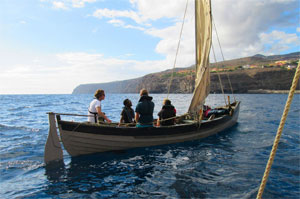 |
|
Whaleboats of that era were not rigged for sailing but the Essex crew fashioned jury-rigs to carry them 4,000 miles to South America. |
Signaling advantage
A comparison of survival then versus now isn’t complete without some mention of other survival equipment. Today, of course, we enjoy numerous effective signaling devices, including EPIRBs, hand-held VHFs, flares, dye markers, lasers — not that these are any guarantee of rescue. I carried an EPIRB and arsenal of flares and, although EPIRB signals are now picked up by satellites, false alarms are epic, malfunctions not unknown, and help just might be very far off. If stuck afloat for any time, food and water become prime issues. The Essex crew seemed not to make much of an effort at fishing, but today we know how to live off the ecosystems that usually develop around survivors in slow-moving craft. We carry fishing kits, tridents, spear guns and/or Hawaiian slings to harvest our swimming companions.
Survivors today also benefit from advanced survival foods, created largely during and after World War II. Water, however, is even more critical than food. Nineteenth-century survivors had to rely solely on water collection, which today remains important, but today’s survivors also hugely benefit from advances in producing it. During World War II, solar stills were created to distill fresh water from salt. These have largely been difficult to use, though, and not all that effective. On the other hand, today’s “reverse-osmosis” or RO hand pumps have proven to be extremely efficient and can supply survivors with virtually unlimited quantities. Although it takes effort, properly hydrated survivors are in much better shape to do that and other work.
Each craft brings a broad mix of attributes to the survival voyage, each of which also varies in its demands. Survival craft, almost by definition, often, if not constantly, are on the edge of their capabilities. Survivors, even if experienced mariners, have not expected to face the reality that is before them in whatever craft they find themselves. Still, today’s improved options for buoyancy, stability, maneuverability and environmental protection — not to mention the critical gear that can supply essential needs, such as water — give modern mariners a real edge over those who struggled to survive 200 years ago. Having survived 76 days in a life raft with a generous amount of relatively modern equipment, I’m in awe of the deprivation the men of Essex endured. It’s my hope that crews of this era, given adequate survival training, as well as improved survival craft and gear will never suffer as much again.
Steven Callahan is a sailor, yacht designer, marine writer, public speaker and technical advisor to feature films.

